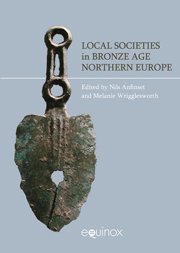Book contents
- Frontmatter
- Contents
- List of figures and tables
- Contributors
- Acknowledgements
- Introduction: local societies, regions and processes of cultural interaction in the Bronze Age
- PART I IDENTITY, GRAND NARRATIVES AND NETWORKS
- PART II REGIONS, GLOBALIZATION AND RESISTANCE
- 7 Northwestern Russia at the periphery of the north European and Volga-Uralic Bronze Age
- 8 Local centres in the periphery: the Late Neolithic, Bronze Age and Early Metal Age in Finland
- 9 The Nordic Bronze Age and the Lüneburg culture: two different responses to social change
- 10 Pottery, transmission and innovation in Mälardalen
- 11 Social landscapes of Bronze Age Scandinavia
- 12 The origin of a Bronze Age in Norway: structure, regional process and localized history
- 13 Social response or resistance to the introduction of metal? Western Norway at the edge of the “globalized” world
- Index
12 - The origin of a Bronze Age in Norway: structure, regional process and localized history
from PART II - REGIONS, GLOBALIZATION AND RESISTANCE
- Frontmatter
- Contents
- List of figures and tables
- Contributors
- Acknowledgements
- Introduction: local societies, regions and processes of cultural interaction in the Bronze Age
- PART I IDENTITY, GRAND NARRATIVES AND NETWORKS
- PART II REGIONS, GLOBALIZATION AND RESISTANCE
- 7 Northwestern Russia at the periphery of the north European and Volga-Uralic Bronze Age
- 8 Local centres in the periphery: the Late Neolithic, Bronze Age and Early Metal Age in Finland
- 9 The Nordic Bronze Age and the Lüneburg culture: two different responses to social change
- 10 Pottery, transmission and innovation in Mälardalen
- 11 Social landscapes of Bronze Age Scandinavia
- 12 The origin of a Bronze Age in Norway: structure, regional process and localized history
- 13 Social response or resistance to the introduction of metal? Western Norway at the edge of the “globalized” world
- Index
Summary
The Late Neolithic and Early Bronze Ages in most of southern Norway represent a socio-cultural order that radically differs from that of the preceding periods (Prescott & Walderhaug 1995; Prescott 1996). The transition to the Late Neolithic, in 2400–2350 BCE, is marked by dramatic changes in production, economy, settlement, social relations, material culture and technology – virtually every conceivable facet of the institutional and ideological constitution of society. This shift, probably among the most dramatic in the region's history, raises issues concerning the institution of a political economy, hierarchical ideologies and hereditary political power. Viewing these institutions in a historical perspective it becomes necessary to identify the context of transformation – when did the historical trajectory change course, and how? These general-level questions engage fundamental and classic archaeological research problems, often studied as discrete themes, concerning the establishment of farm institutions, metallurgy and maritime practices, as well as novel forms of rituality, cosmology, exchange and scales of interaction.
Discussions concerning the scenario outlined above in the late prehistory of Norway – the late part of the “Neolithic” and the Bronze Age – are often structured around dichotomous positions: structure versus history, local evolution versus regionally/continentally determined historical developments, centre versus periphery, and so on. The polarized nature of this basic explanatory repertoire has perhaps reached the limits of its potential for resolving problems and generating knowledge.
- Type
- Chapter
- Information
- Local Societies in Bronze Age Northern Europe , pp. 215 - 231Publisher: Acumen PublishingPrint publication year: 2012

